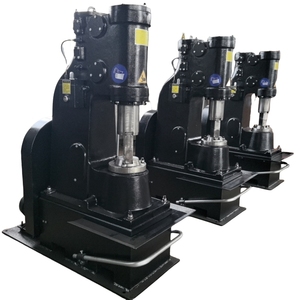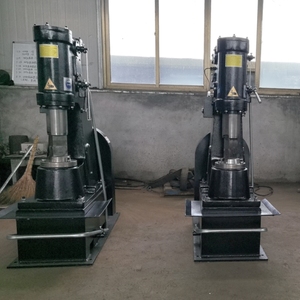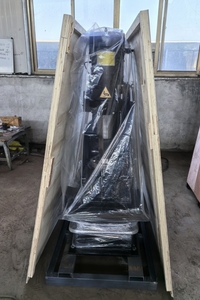
All categories
Featured selections
Trade Assurance
Buyer Central
Help Center
Get the app
Become a supplier

(1061 products available)














































The taps forging machine makes taps, which are cutting tools used for creating internal threads in various materials. The machine can be divided into four main types based on its application, automation, pressure capacity, and design.
Based on application
The heavy-duty taps forging machines are multi-station presses suitable for larger volumes of metal parts. They have higher pressure ratings and are conducive to efficient high-speed production lines. The smaller, bench-top forgers are suitable for small operations or startups with limited budgets and form the basis of tap forging technology. Intermediate forgers are standalone machines and are more powerful than bench forgers. They are ideal for medium-sized operations that do not need the more extensive capabilities and higher energy consumption of heavy-duty forgers.
Based on automation
Automatic taps forging machines make the processes easier by automating the feeding of the workpieces and the clamping. Users have to do less manual work other than operating the machine. Manual forgers are usually operated by hand, meaning that operators have more control over the final product.
Based on pressure
High-pressure taps forging machines apply higher pressures to forge tougher metals, leading to more resilient products. Low-pressure forging machines use less pressure, which is gentler on the metal, to create more malleable products.
Based on design
Open-back forging presses have spaces at the back so operators can access the die and lubricate it regularly. Closed-back designs are suitable for operations that require more solid construction and support, as they do not have spaces at the back. Operators only need to access the die periodically. Open-back machines may be more suitable for closed-back machines in some cases. Pneumatic forging machines use air to apply the forging pressure, while hydraulic presses use oil.
Capacity:
Taps forging machines have different capacities based on the size of the machines. They can make 100 to 1,000 pieces of taps in an hour. Big machines make more taps in less time.
Power:
These machines use electricity. Small machines use 5 to 10 kilowatts. Bigger machines use more, about 20 to 50 kilowatts. They need more power to run faster and make more taps.
Sizes:
Taps forging machines come in different sizes to make various tap sizes. The small ones can make taps from 1/8” to 2", and big industrial ones can make from 3/8” to 6” sizes. The bigger machines have more powerful tools in them.
Materials:
These machines can work with many steel types, like carbon steel, alloy steel, or stainless steel. They have special parts that let them handle different kinds of metal with varying qualities and concentrations of materials. This allows the machines to create durable taps that meet the industry's standards and requirements.
Automation:
Some machines have more computer controls. The basic ones have manual controls for some things, while other more advanced models have automated CAD systems for everything. More automation helps the machines make more accurately and quickly.
Forms of production:
These machines use different methods to make taps, like CNC computer control, hydraulic pressure to shape materials, Open Die Forging for flexibility, Closed Die Forging for precision in shapes, and Drop Forging where the drop hammer hits the sap metal molds in the machine. Each way has its specialty and is used for specific tap types.
To keep the machines running well and avoid breaking down, it is important to follow a regular maintenance schedule. Some of the routine checks that are done at specific times include:
According to a Research and Markets report, the global tap market size was valued at $1.7 billion in 2022 and is projected to reach $2.3 billion by 2032. This growth is attributed to the increasing demand generated from the machinery industry.
As the need for pipeline construction, high-precision metal parts, and the oil and gas industry continues to grow, an immense application industry for taps forging machines exists.
Several industry applications make use of this machine to manufacture the essential metal pieces required to make drills, taps, dies, and other instruments.
Here is a non-exhaustive list of industries using these machines:
Consider these parameters for the machines in this industry:
Machine type
Know if the item required uses a vertical or horizontal style. Both of them are great, but they serve different uses. The horizontal ones can attain various angles on the workpieces. It does this while keeping the tap in a right state. Many customers love these for their versatility. On the other hand, the vertical item has a powerful unit. These units give it enough strength to tackle different jobs. Most smaller firms that don't do large jobs use this model.
Thermal treatment
A good tapholder machine for business uses heat to strengthen the steel. Many suppliers do this with an electric furnace. This part puts the steel at a higher temperature before cooling it very fast. This cycle boosts the strength of the steel, so it can hold jobs well for a long time. Many business buyers care about thermal treatment. This is because it makes the tools better and can handle more work. Loosely treated steel will wear out easily, so customers will have to replace them every time.
Tool holder
Think about the tools that will go into the machine. Heavy-duty operations need stronger holders. These holders can hold heavy drills so they won't break easily. In bigger machines, the holder has a power rating of above 5 KVA. This rating means it can hold taps with a higher workload. Smaller machines power holders go up to 2.5 KVA.
Hydraulic system
An advanced hydraulic system helps the machine carry heavy drill bits. It does this while enabling smooth movement and tapping actions. Many hydraulic systems have great strength and last a long time. Their longevity means they won't need repair or service often. This keeps the running cost very low.
Safety features
The safety parts of the machine must work well and match industry standards. Suppliers put emergency stop buttons on the machines. These buttons let operators quickly stop the machine during issues. Other devices are sensors to block accidental clashes. These detect potential tap and workpiece clashes and stop the machine. Some machines have guards and covers that shield operators from the moving parts.
Q1: What is the difference between hot and cold forging in taps manufacturing?
A1: Hot forging involves heating the metal before shaping it, enhancing its malleability and reducing tool wear. On the other hand, cold forging taps machines forges metal at room temperature, improving structural integrity, albeit at a higher cost and with greater tooling challenges.
Q2: What materials are used in forging tap devices?
A2: Various materials can be used for the forging die, including, but not limited to, alloy steel, carbon steel, tool steel, or specialized materials like beryllium copper for certain applications, and the choice of material affects the die's durability, conductivity, and performance.
Q3: How does one maintain a forged taps machine?
A3: Regular cleaning, lubrication of moving parts, calibration, routine checks for wear and tear, especially on dies and cutting tools, and timely replacement of consumed forging oils can ensure optimal performances.
Q4: What are the common defects in forged taps and how can they be avoided?
A4: Defects such as inadequate fill, surface flaws, dimensional inaccuracies, or cracks can be avoided by maintaining proper die temperatures, using appropriate material flow, and adhering to quality control during the forging process.
Q5: Can any metal be tapped through a forging machine?
A5: While many metals like steel, aluminum, brass, and titanium can be forged, some, like lead or certain alloy combinations, pose unique challenges or require specialized processes, making them less feasible for conventional forging techniques.